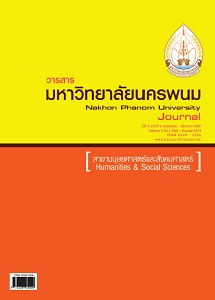ผลการเรียนรู้ภาษาไทย เรื่อง ชนิดและหน้าที่ของคำ โดยการจัดกิจกรรมด้วย กลุ่มร่วมมือเทคนิค STAD ของนักเรียนชั้นมัธยมศึกษาปีที่ 1
Main Article Content
Abstract
การวิจัยครั้งนี้มีวัตถุประสงค์เพื่อ 1) พัฒนาแผนการจัดการเรียนรู้ เรื่อง ชนิดและหน้าที่ของคำ โดยการจัดกิจกรรมด้วยกลุ่ม ร่วมมือเทคนิค STAD ของนักเรียนระดับชั้นมัธยมศึกษาปีที่ 1 ให้มีประสิทธิภาพตามเกณฑ์ 80/80 2) หาค่าดัชนีประสิทธิผลของ แผนการจัดการเรียนรู้และ 3) ศึกษาความพึงพอใจของนักเรียนที่มีต่อการจัดกิจกรรมการเรียนรู้ด้วยกลุ่มร่วมมือเทคนิค STAD กลุ่ม ตัวอย่างที่ใช้ในการศึกษาครั้งนี้ ได้แก่ นักเรียนชั้นมัธยมศึกษาปีที่ 1 ภาคเรียนที่ 2 ปีการศึกษา 2554 ของโรงเรียนนครพนมวิทยาคม ตำบลในเมือง อำเภอเมือง จังหวัดนครพนม จำนวน 37 คน ได้มาโดยการสุ่มแบบกลุ่ม (Cluster Random Sampling) เครื่องมือที่ใช้ใน การศึกษาครั้งนี้ได้แก่ แผนการจัดการเรียนรู้โดยการจัดกิจกรรมด้วยกลุ่มร่วมมือเทคนิค STAD เรื่อง ชนิดและหน้าที่ของคำ ชั้นมัธยมศึกษาปีที่ 1 จำนวน 7 แผน แบบทดสอบผลสัมฤทธิ์ทางการเรียน จำนวน 40 ข้อ เป็นแบบปรนัยชนิดเลือกตอบ 4 ตัวเลือก มีค่าความยากระหว่าง 0.28-069 อำนาจจำแนกระหว่าง 0.31-0.75 และค่าความเชื่อมั่น 0.72 แบบวัดความพึงพอใจของนักเรียนที่มีต่อ การจัดกิจกรรมการเรียนรู้ด้วยกลุ่มร่วมมือเทคนิค STAD เป็นแบบมาตราส่วนประมาณค่า (Rating Scale) 5 ระดับ จำนวน 20 ข้อ มีค่าอำนาจจำแนกระหว่าง 0.46-0.84 ค่าความเชื่อมั่น 0.92 สถิติที่ใช้ในการวิเคราะห์ข้อมูลได้แก่ ร้อยละ ค่าเฉลี่ย ส่วนเบี่ยงเบน มาตรฐาน ผลการวิจัยพบว่า 1) แผนการจัดการเรียนรู้ เรื่อง ชนิดและหน้าที่ของคำ โดยการจัดกิจกรรมด้วยกลุ่มร่วมมือเทคนิค STAD มีประสิทธิภาพเท่ากับ 88.87/83.24 2) ดัชนีประสิทธิผลของการเรียนรู้ด้วยแผนการจัดการเรียนรู้ เรื่อง ชนิดและหน้าที่ของคำ ชั้นมัธยมศึกษาปีที่ 1 โดยการจัดกิจกรรมด้วยกลุ่มร่วมมือเทคนิค STAD มีค่าเท่ากับ 0.6616 แสดงว่านักเรียนมีความก้าวหน้าใน การเรียนเพิ่มขึ้น ร้อยละ 66.16 3) นักเรียนชั้นมัธยมศึกษาปีที่ 1 มีความพึงพอใจต่อการจัดกิจกรรมการเรียนรู้แบบกลุ่มร่วมมือเทคนิค STAD กลุ่มสาระการเรียนรู้ภาษาไทยในระดับมาก
The purposes of this study were: 1) to develop a lesson plan entitled ‘The Type of Word and Its Function’ by the organization of activity with the STAD cooperative technique for Mathayom Suksa 1 students to reach the efficiency of the 80/80 criterion, 2) to examine a value of effectiveness index of the lesson plans, and 3) to investigate students’ satisfaction with the organization of learning activity with the STAD cooperative technique. A sample used in this study as selected by cluster random sampling was 37 Mathayom Suksa 1 students enrolled in the second semester of academic year 2011 at Nakhon-Phanom-Withayakhom School, Nai-Mueang sub-district, Mueang district, Nakhon Phanom province. The instruments used in this study were 7 lesson plans through the organization of activity with STAD cooperative technique entitled ‘The Type of Word and Its Function’ for Mathayom Suksa 1 students, a 40-item learning achievement objective test with 4 choices whose difficulty values ranged between 0.28 and 0.69, discrimination power values between 0.31 and 0.75 and reliability value was 0.72, and a form for measuring students’ satisfaction with the organization of learning activity through STAD cooperative technique which comprised 20 items and a scale of 5 ratings whose discrimination power values ranged between 0.46 and 0.84 and reliability value was 0.92. Statistics used to analyze data were percentage, mean and standard deviation. The findings were as follows: 1) The lesson plans entitled ‘The Type of Word and Its Function’ through the organization of activity with STAD cooperative technique had efficiency of 88.87/83.24; 2) the effectiveness index of learning using the lesson plans entitled ‘The Type of Word and Its Function’ for Mathayom Suksa 1 students through the organization of activity with STAD cooperative technique had a value of 0.6616, showing that their advance of learning had an increase of 66.16%; 3) Mathayom Suksa 1 students were satisfied with the organization of learning activity in the substance group of learning the Thai language at high level.


